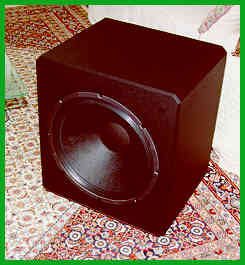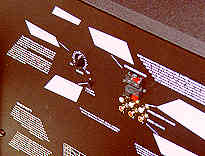Product Review - Bag End "ELF"
INFRASUB-18 Self-Powered Subwoofer - December, 1997
J.E. Johnson, Jr.
![]()
 |
Bag End
INFRASUB-18 18" Driver - Sealed Enclosure - 3/4" MDF Manufacturer's FR Specs: 8 Hz - 95 Hz � 3 dB Built-in Amplifier: 400 watts rms Size: 23 1/2" H x 21 1/4" W x 18 1/4" D Weight: 92 pounds Price: $1,495 USA (Black vinyl finish)
|
| Bag End Loudspeaker Systems, P.O. Box 488, Barrington, Illinois 60011; Phone 847-382-4550; Fax 847-382-4551; E-Mail [email protected]. |
The first thing you might be thinking is, "What does ELF mean?" ELF is Bag End's acronym for "Extended Low Frequency". Bag End does things differently than other subwoofer manufacturers. The concept is not new, but it is rather unique. For most subwoofers, the resonant tuning frequency is within the normal operating range, say 25 Hz for a subwoofer that has a response from 20 Hz to 120 Hz. A problem can arise in the smoothness with which the speaker responds below the tuning frequency, at the tuning frequency, and above the tuning frequency. Various manufacturers approach this problem in different ways. Bag End's approach is to make the tuning frequency above the typical operating area, i.e., 63 Hz. That way, below 63 Hz, which is where most subwoofers do their thing, there is none of the usual difficulty. This requires a high free air resonance (fs) for the driver. In the case of the INFRASUB-18, this number is 63 Hz. Of course, there is no free lunch, and if this were the obvious way to make all subs, then all subs would be made this way. A major problem with this type of design, in a sealed enclosure, is that there is a natural rolloff below the resonant frequency at the rate of 12 dB/octave. So, what Bag End does is use what they call a "Dual Integrator" which consists of two integrators (operational amplifiers - see glossary) in series, and this increases the frequency response below the resonant frequency at the rate of 12 dB/octave, down to 8 Hz. This counteracts the natural rolloff. The dual integrator takes the place of a low-pass crossover filter (and is situated in front of the amplifier), and thus, there is no time delay (phase shift) varying in amount depending on how far away the reproduced frequency is from a low-pass crossover frequency.
The INFRASUB-18 uses an 18" driver, weighing about 12 pounds.
The driver looks conventional. The built-in amplifier is rated at 400 watts rms. On the
rear of the enclosure are the detached AC cord socket (grounded), on/off toggle, polarity
reverse (the dual integrator does cause a 1800 shift, but this occurs equally
across the entire response, and can be reversed depending on user needs), volume control,
two sets of speaker-level input/outputs spring clips, and three sets of line-level
input/output jacks (RCA).  The three line-level jack
pairs are for left, center, and right channels, and provide a 95 Hz high-pass back to
other power amplifiers. The inside of the enclosure has the driver with connecting wire to
the amplifier, which is walled off from the driver, but housed within the main enclosure.
The enclosure has bracing along the edges, and there is no damping material (stuffing).
The three line-level jack
pairs are for left, center, and right channels, and provide a 95 Hz high-pass back to
other power amplifiers. The inside of the enclosure has the driver with connecting wire to
the amplifier, which is walled off from the driver, but housed within the main enclosure.
The enclosure has bracing along the edges, and there is no damping material (stuffing).
We tested the INFRASUB-18 with a reference audio system consisting of Audio Alchemy CD Transport, Jitter Reduction, and DAC, Audio Electronic AE-1 Class A, Single Ended Triode Preamplifier, White Audio B-80 Monoblock Amplifiers, Monitor Audio Floorstanding Speakers, and Nordost Flatline Interconnects and Speaker Cables. We also connected the sub to our home theater system, which has a Yamaha LD Player, Toshiba DVD Player, Yamaha Receiver, AudioControl Equalizer, Carver Power Amplifier, Krix Floorstanding Speakers, and Nordost Cables. Various CDs, LDs, and DVDs were used, all of which have deep bass.
I think what was most noticeable about the Bag End was the astonishing time alignment with the rest of the music or movie sound tracks. The blend of the deep bass into the complete system was seamless. In other words, I could not tell where the other speakers left off and the Bag End began. The tradeoff was that the Bag End did not play as loud as any of our other reference subwoofers. That may be a limiting factor when employing a driver whose fs is so high, and increasing the amount of power amplification at 12 dB/octave below resonance. There was a considerable amount of harmonics, evidenced by audible tones when using sine waves below 20 Hz. They were not objectionable, however.
| Room Response - Bag End INFRASUB-18 |
| 1 meter, grille off | 13 feet, grille off |
| 10 Hz | 87.3 dB | 10 Hz | 88.0 dB |
| 12.5 Hz | 93.6 dB | 12.5 Hz | 94.6 dB |
| 16 Hz | 87.6 dB | 16 Hz | 93.3 dB |
| 20 Hz | 89.7 dB | 20 Hz | 89.6 dB |
| 25 Hz | 94.3 dB | 25 Hz | 90.1 dB |
| 31.5 Hz | 94.7 dB | 31.5 Hz | 83.9 dB |
| 40 Hz | 97.3 dB | 40 Hz | 85.9 dB |
| 50 Hz | 95.6 dB | 50 Hz | 86.1 dB |
| 63 Hz | 96.1 dB | 63 Hz | 94.8 dB |
| 80 Hz | 91.2 dB | 80 Hz | 84.2 dB |
| 100 Hz | 90.2 dB | 100 Hz | 83.2 dB |
| 125 Hz | 85.4 dB | 125 Hz | 68.1 dB |
| 160 Hz | 82.0 dB | 160 Hz | 73.9 dB |
The room response is relatively flat below 63 Hz, just as Bag End says, and is down only 7 dB at 10 Hz from what it was at 25 Hz for the nearfield test. The reason Bag End makes the sub respond to 8 Hz is to keep the 20 Hz region (which is audible to human ears) flat. We could get a maximum of 103.5 dB at 31.5 Hz using nearfield testing, before the amplifier clipped.
The biggest selling feature of the INFRASUB-18, to me, would be the time alignment. Bag End has been in the professional arena for quite a while, and the profesional version of this subwoofer is used in theaters, television networks, post production studios, Disney World, museums, etc. In the last few years, they have moved to the consumer marketplace with additional products. I would imagine that theaters really like the time alignment feature, since the deep bass is always in sync with other sound systems regardless of frequency. However, they do use the professional version, and in multiple units.
In summary, Bag End moves to the consumer arena with their ELF designs in the INFRASUB-18. The sound quality is rather unique. If time alignment at all low frequencies, rather than high SPL, is your thing, this is definitely worth auditioning.
John E. Johnson, Jr.
![]()
� Copyright 1997 Secrets of Home Theater & High Fidelity
Return to Table of Contents for this Issue.

